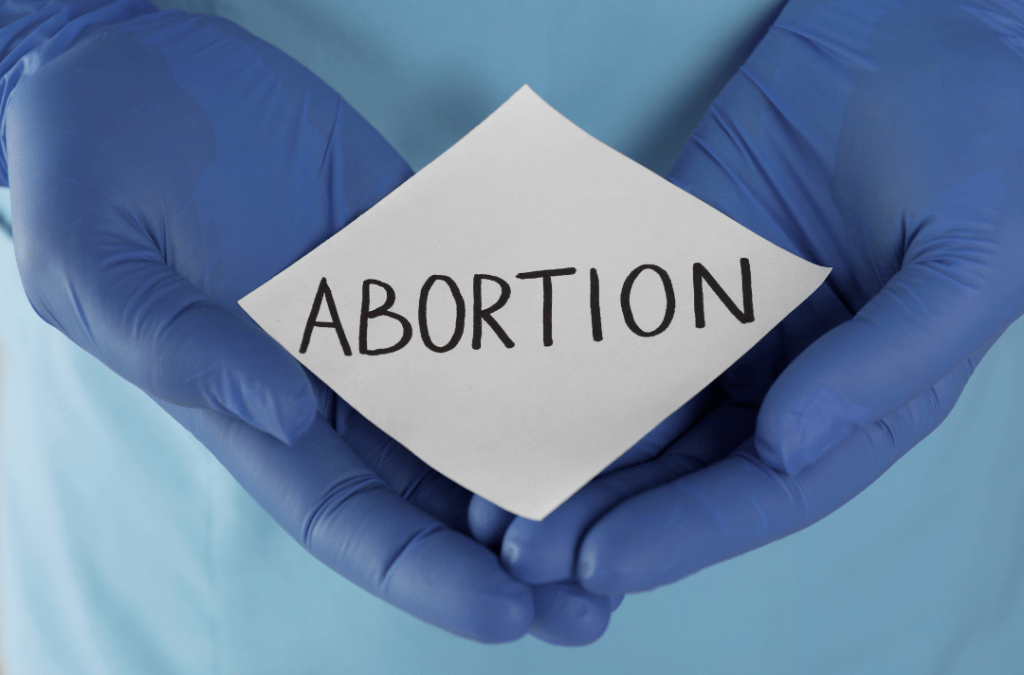It is common to bleed for 1 to 2 weeks after either form of abortion. For some people, the blood flow will stop before restarting. After one or two weeks, the bleeding should decrease. You may experience some light bleeding or spotting for a few weeks afterwards or until your next period. All these types of bleeding is normal after an abortion.
Abortion bleeding days:
If you choose to have a medical abortion, you will most likely experience most of the bleeding on the day/the first day you take misoprostol. Compared to in-clinic or surgical abortion, medical abortion appears to result in more bleeding, which lasts an average of nine days. You might not bleed much, or at all, for the first few days after an surgical abortion. You may begin to bleed 3 to 5 days later, around the same amount as your regular menstrual cycle. Depending on whether you had a medical or surgical abortion, light bleeding could continue for a few days to about two weeks. Bleeding may come and go for a few people. According to some reports, spotting after abortion may continue for up to four weeks following an abortion or even longer for some people.
It’s common to experience some bleeding after an abortion. Here is what to expect if you use abortion pills or undergo a surgical abortion:
- In-clinic or surgical abortion – You may experience bleeding that differs slightly from your period immediately following your surgical abortion. You can experience spotting for several weeks or heavy bleeding with clots for a few days. Moreover, some people don’t bleed at all. It is all normal.
- Abortion pills – Firstly, you should talk to your doctor about how to take abortion pills. When having a medication abortion, you’ll experience severe cramping and bleeding. The cramping and bleeding typically begin one to four hours after taking misoprostol for most people. It’s common to have an abortion that feels like a very heavy period or miscarriage, with large blood clots (up to the size of a lemon) or tissue clumps. But if you don’t bleed for 24 hours or experience bleeding 1 day after abortion (taking misoprostol), call your doctor immediately.
The cramps and bleeding may continue for several hours. The pregnancy tissue is typically eliminated in 4-5 hours, although it may take longer. The cramping and bleeding should eventually stop after the pregnancy tissue comes out and your abortion is over. For several weeks post your abortion, it’s typical to experience some bleeding and spotting.
Normal bleeding vs abnormal bleeding after abortion –
- Normal bleeding – Normal bleeding after an abortion varies from person to person, but typically lasts for about 2 weeks. It is common to experience bleeding for several days to a few weeks after the procedure. However, the duration can vary based on factors such as the type of abortion performed and factors like overall health and hormonal levels of the individual person.
In terms of the amount of blood loss, it is normal to have bleeding comparable to or slightly heavier than a menstrual period. This can involve passing blood clots as well. It is important to note that the bleeding may not be constant throughout this period and can range from light to heavy flow.
Characteristics of normal bleeding after an abortion can be described by the colour and consistency of the blood. Initially, the bleeding may be bright red, similar to a heavy period. As time progresses, the colour of the blood may transition to a lighter shade, eventually resembling a pinkish or brownish discharge. The consistency may also change from liquid to thicker discharge or blood clots.
- Abnormal bleeding – On the other hand, abnormal bleeding after an abortion should be monitored closely. Some symptoms may indicate that bleeding is outside the normal range. These symptoms include excessive heavy bleeding that requires changing pads every hour for several consecutive hours, passing large blood clots consistently, experiencing severe abdominal pain that is not relieved with over-the-counter pain medication, or prolonged bleeding that shows no sign of reduction.
Abnormal bleeding can have several causes. It may be the result of retained products of conception, which means that not all the pregnancy tissues were removed during the abortion procedure. Other causes can include infection, cervical or uterine injury, or an underlying medical condition. If abnormal bleeding is suspected, it is crucial to seek medical attention immediately to determine the cause and receive appropriate treatment.
In summary, normal bleeding after an abortion involves a duration that can range from several days to a few weeks. The amount of blood loss is usually slightly heavier than a normal menstrual period, and the colour and consistency of the blood may change over time. Abnormal bleeding may exhibit symptoms such as excessively heavy or prolonged bleeding, passing large blood clots consistently, or severe abdominal pain. If any of these symptoms occur, it is important to consult a doctor to evaluate and address the underlying cause. 1 2
Birth control method after abortion:
Most birth control methods, such as the pill, patch, condom, implant, and intrauterine device (IUD), can be used again immediately or a short while after your abortion. You might need to wait around 4 weeks after a second-trimester abortion before using insertion-only techniques like the diaphragm, cervical cap, or IUD. Hormonal birth control methods, such as the pill, may reduce the days you bleed after an abortion. If you take the pill, you might resume your regular menstrual cycle faster. Remember, it is important to consult with your doctor to determine the most suitable birth control method for you based on your medical history, lifestyle, and preferences. 3
How to stop bleeding after abortion?
You should be aware of how to stop bleeding after abortion pill or if you had a surgical abortion. If you have heavy bleeding (soaking a full-sized maxi-pad in one hour or spilling over and soaking clothes) occurs, then you can do deep uterine massaging for 10 minutes, take Tranexamic acid tablets, use a heating pad, and decrease the activity. It is important to manage bleeding after an abortion properly. Rest is crucial, so take it easy and avoid strenuous activities. Stay hydrated by drinking plenty of water. Use sanitary pads instead of tampons to prevent infection. Avoid sexual intercourse until the bleeding stops to reduce the risk of complications. Monitor bleeding, but remember that it can vary in duration and intensity. But, if the heavy bleeding continues for more than three hours, call your doctor. 3
Should I still be bleeding 3 weeks after miscarriage or abortion?
It is okay to still bleed for 3 weeks after abortion. You’ll feel cramps and have a lot of vaginal bleeding (symptoms similar to a heavy period) on day one. In most hospitals, you’ll be sent home to complete the abortion if medically done. It is safe, but if the bleeding intensifies, call your doctor.
Is it normal to still bleed 6 weeks after abortion?
Yes, it can be. Some people may experience post abortion bleeding that lasts for two to six weeks. Bleeding may be spotty, dark brown, and contain clots. If you are having heavy bleeding or feel something is unusual, do not hesitate to call your doctor. 5
How do you calculate ovulation after an abortion?
Ovulation should start about two weeks after passing the pregnancy. It implies that even if you haven’t had a period after an abortion, you can get pregnant again. In most cases, having an abortion does not impact your ability to conceive. Hence it is important to use contraception. The fear is that repeated surgical abortions could cause damage to the uterus from the tools used to remove the pregnancy. This scarring, known as intrauterine adhesions, may be the source of fertility issues.6
Can a pregnancy test still be positive 3 weeks after miscarriage or abortion?
After a miscarriage or abortion, you will continue to test positive for pregnancy until your BhCG levels return to normal. It takes 12 to 16 days for BhCG to disappear from the body on average, although this might vary depending on how high your BhCG level was at the time of your miscarriage or abortion. A chemical pregnancy, or very early pregnancy loss, can take about a week to return to zero, but a later-stage abortion can take up to a month or longer.
Can you get a faint positive pregnancy test 7 weeks after abortion?
If you had a second trimester abortion, it can take up to 1-2 months for your BhCG levels to return back to zero. If you are still showing up positive on a pregnancy test after a first trimester medical abortion and it has been more than a few weeks since, you should see your doctor. Your doctor might perform blood tests to check your BhCG levels (a quantitative hCG). They can use an ultrasound to confirm that a complete abortion has taken place. If your blood pregnancy test results stay positive, there are a few possibilities to consider. You could be pregnant again, there could be some pregnancy tissue left in the uterus (incomplete abortion), or it could be an abnormal growth of placental tissue (molar pregnancy). 7
How many months after abortion can I get pregnant?
The normal menstrual cycle will begin again after an abortion. In a 28-day menstrual cycle, ovulation, or the release of an egg from the ovary, usually happens around day 14. It indicates that you’ll probably ovulate a few weeks after having an abortion. In other words, even if you haven’t started your period yet, it is physically possible to get pregnant again if you have unprotected sex after an abortion.
But, since not everyone has a 28-day cycle, the precise date may change. Some women’s menstrual cycles are naturally shorter. They could conceive even earlier because they might start ovulating just eight days following the procedure. The stage of your pregnancy at the time of the abortion will also affect how long it takes you to ovulate. Sometimes, after the procedure, pregnancy hormones may continue to linger in your body for a few weeks. As a result, this can delay ovulation and menstruation.8
How long after an abortion does it take for your BhCG levels to go down?
After an abortion, the precise time it takes for BhCG to leave your system might range from a few days to a few months. The exact timing depends on the BhCG level when the pregnancy was terminated. In general, a woman who has a very early abortion will probably experience a faster return to zero of her BhCG levels than someone whose had an abortion at a later stage of pregnancy. Yet, even after an abortion, the level of BhCG may remain high enough to show as a positive pregnancy test. If you think you could be pregnant again, remember that a false positive is possible.
The average time for BhCG levels to return to normal is one to nine weeks. After an abortion, miscarriage or delivery, it usually takes one to nine weeks for BhCG levels to drop to zero. When levels reach zero, the body has returned to its pre-pregnancy state and is most likely ready for conception to occur once again.9
Can you ovulate while bleeding?
Ovulation can start as soon as two weeks after a pregnancy is terminated. Most women experience a week or so of bleeding after an early abortion. If the abortion happened in the late first or second trimester, bleeding can linger longer. Spotting may also occur for up to four weeks. Your menstrual cycle will start again once the bleeding lessens and hormone levels return to normal. Many women see their period again 4 to 6 weeks after an abortion.11
Can I take misoprostol at night or morning?
Misoprostol is best given with or after meals and during bedtime (at night) unless otherwise prescribed by your doctor. Always take this medication with food or milk to help prevent loose stools, diarrhea and abdominal cramps.12
Why do I feel movement in my stomach after an abortion?
Those who have experienced an abortion or miscarriage may feel some movement in their stomach. People who have been pregnant also experience a sensation that a baby is inside their abdomen even after delivery. This sensation or feeling is known as phantom kicks and disappears after a while.13






